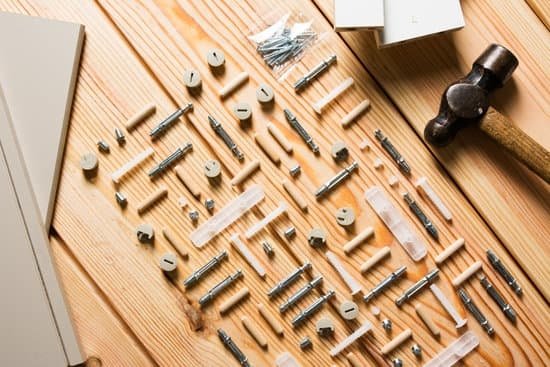Introduction
The woodworking spline joint is a type of miter joint which uses an additional piece of material (usually thinner than the material being joined) as an extra reinforcement along its length. It is commonly used in furniture and cabinet making, as well as other woodworking projects, to create a strong, seamless bond between two pieces of wood. The spline is inserted into a groove that has been cut into each piece to be joined.
One of the main benefits of using a spline joint over other types of miter joints, such as dowels or biscuits, is that it makes for cleaner, stronger connections by distributing stress evenly throughout the entire joint and spanning any gaps due to factors like shrinkage or imperfect cuts. Once dry-fit together with the spline in place, the joint can then be glued or fixed with screws or nails for added stability and rigidity.
The use of splines allow for simple adjustment during assembly and make for easy development shapes without having to resort to more involved processes such as biscuit joinery. Additionally, they lend themselves to more traditional furniture-making techniques such as dovetail joints somewhat seamlessly due to their relatively thin profile. This can result in eye-catching pieces where otherwise there would have been complex contours that would have made alternative forms difficult to achieve due to equipment availability or skill level requirements.
Due when working with splines:
When working with any type of joinery technique it’s important not to rush through any part of the process and pay close attention during every step”particularly when dealing with woods materials that are susceptible to expansion/contraction with fluctuations in humidity/temperature (as this can lead to any fitting becoming loose over time). Furthermore, always make sure all tools used are properly maintained and sharpened before starting a project”especially those meant for cutting delicate grooves or intricate patterns like saw blades intended for joinery work. Additionally, allowing plenty time within each step will likely yield better results than trying to rush down the list quickly”which could lead in poor performance from whichever tool associated with activity was chosen at hand.
Types of Spline Joints
The woodworking spline joint is an excellent way of joining two boards together without compromising the overall strength of the joints. There are various types available, each offering its own particular advantages depending on the project.
The most common type is a miter spline joint. This type uses a cross-shaped slot cut into both pieces of wood and a corresponding cross-shaped spline that fits into the slots perfectly. This type of joint provides maximum strength and stability, as well as an interlocking effect that helps keep everything secure. A sample project could be making frames for art or photographs with this style joint.
Sliding dovetail splines are another popular choice, which work by having both boards feature a dovetail shape cut outs which allows them to slide into each other sideways but when in place become very secure. These are ideal for fitted furniture projects since they provide extra strength along with durability and dependability. An example project could be creating drawers for cabinetry using this style joint.
Rabbet Splines are also worth mentioning, as these consist of rabbetted edges coming off either side of one piece of wood that fit into corresponding grooves in the opposite board; providing strong connections without compromising clarity or precision in detail work making them great for ornamental projects such as frames and boxes. An example project could be creating wooden planters or window boxes with rabbet splines to help keep everything stable while being aesthetically pleasing at the same time.
How to Make Spline Joints
1. Cut the miter along the edge of each piece with a handsaw or table saw. Make sure that the edges of each piece form a tight joint when placed together and that the angles are cut precisely to ensure a secure fit.
2. Measure out the length of spline material you’ll need to fill in each miter joint. The dimensions of your spline should be the same width as the gap between your two pieces and at least twice as thick.
3. Cut your splines using either a bandsaw, jigsaw, or hand saw and make sure you have a neat finish on all four sides.
4. Sand down any rough edges from cutting, then use wood glue to attach one end of each spline into one side of its corresponding miter joint.
5. Using a hammer and chisel, knock in the remaining splines until they’re snugly in place and even with the surface plane on both sides of your woodworking project. The idea is for them to remain slightly proud if necessary ” this will provide additional strength for maximum hold at each joint point when secured with glue or nails/screws later on in assembly stages (optional).
6. Gently tap down excess splines with either a mallet or hammer until they are flush with each other and with the surface level plane of both pieces adjacent to it. Use sandpaper on any slight bumps; smooth away sharp edges; flatten out depressions; and clean up excess glue around edges (as shown in visual aids).
Advanced Spline Joints
Advanced spline joints offer many benefits over traditional joinery methods. By creating intricate designs, they can provide a much stronger bond than other joint types. Additionally, these joints can connect pieces of wood with different grain orientations, including cross-grain joining. Their complex shape also helps them resist lateral forces and provides ample surface area for bonding glue.
One type of advanced spline joint is the mitered spline joint. This joint entails cutting two pieces of wood at an angle before inserting a triangular spline into the intersecting cut grooves and gluing them together. The mitered spline offers increased strength compared to standard mortise and tenon joints while providing a much sleeker looking finished product.
The blind box or hidden miter splines have become increasingly popular as well, due to their seamless aesthetic look versus visible joinery when used in furniture making or cabinetry applications. To make this type of joint, an L-shaped cut out is made into one piece of wood which is insulated by a smaller piece that fits within it. The blind box provides superb strength while its subtle components bring visual interest to the design without being overwhelming or taking away from the shape of the entire furniture piece or structure.
Finally, there are dovetail and T-splines which work similarly to each other but using different shapes at their intersection points between two pieces of wood. Dovetail splines create a strong bond when inserted inside dadoes, with their angled surface area increasing surface contact for better adhesion between wood species with different grain directions/orientation. T-splines feature two cuts placed perpendicular to each other, resembling a “T” shape when completed this setup has similar strength capabilities but typically creates smoother edges than traditional mortise and Tenon joinery designs
Best Support Tools and Materials
Tools:
• Router ” This universal power tool is the best for woodworking spline joints, as it can make cuts with precision and accuracy.
• Table Saw ” For making longer straight cuts in your wood pieces before assembly.
• Drill ” Used to measure and mark the locations of slots for the splines when assembling.
• Hammer ” A hammer is helpful for tapping in the splines.
Materials:
It is important to choose the right type of wood for your woodworking spline joints. Different woods have different absorption and gluing characteristics, so select a wood that will work best for your specific project needs. Popular woods are birch, cherry, mahogany, maple, oak, pine and walnut. It’s also important to select quality hardwood lumber as well as good-quality fasteners and adhesives such as construction grade glue or epoxy resin glue.
Best Practices
Do:
• Take your time and pay attention to every detail while cutting the lugs in the mating pieces of wood. A perfectly fitting joint requires proper dowel alignment.
• If you are drilling holes for the splines, use a drill bit size equal to or slightly larger than the thickness dimension of the spline so that it is free to move.
• Use an appropriate adhesive and apply it evenly on both sides of the joint to properly seal and secure it from water damage.
Don’t:
• Don’t try to assemble your joint under unnecessary pressure. Forceful hammering can cause misalignment or damage to the surfaces of the wooden pieces which can undermine its overall strength and stability.
• Don’t rush into cutting your polygons – take measurement twice before you cut to avoid any mistakes that cannot be easily reversed.
Troubleshooting Tips:
• If you find that one side of your joint isn’t fitting correctly, check whether friction is limiting its movement due to inadequate lubrication or if you used oversized dowels which prevents them from entering their intended housing without forcing them in.
• Look out for misalignments when visually checking your completed spline joints, as these could be indicative of something more extensive such as warped wood faces or improper gluing processes having affected the fit of the joint components together.
Final Thoughts
A woodworking spline joint is a unique method of connecting pieces of wood together. Splines are thin strips of wood that are inserted into slots cut in the edges of the two pieces being joined together, providing an enhanced strength and stiffness to a joint. This type of joint is particularly effective when joining materials that have different levels of movement due to humidity or temperature changes, so they’re often used in cabinetry or furniture projects.
There are many benefits to using a spline joint over other joinery methods. They give added strength compared to a normal butt joint, don’t require any specialized tools for installation, and can be combined with other joinery techniques like dovetails and mortise-and-tenon joints for even more reinforcement if needed. Also, splines don’t damage the material’s visible surfaces as much as biscuits or dowels might.
When using splines, there are several things to keep in mind. First and foremost, ensure that the slot cutouts are centered on the workpiece and follow it closely; otherwise, you risk having a weak joint point once assembled. It’s also essential that you select properly-sized splines; if they’re too small for the slot size, your assembly won’t be securely held together; if they’re too large for it, then it might end up being too tight to assemble properly. Lastly, make sure any loose ends on both sides of the slot get cleaned off before inserting the spline into its slot; this will help increase the holding power when put together!
After mastering these construction basics of a woodworking spline joint, projects become much easier and more successful as these types of connections greatly enhance the structural integrity by strengthening corners and edges. With some practice and knowledge about this technique, you’ll be able to complete intricate furniture pieces with confidence! To learn more about working with spline joints, here are some great resources available online: Wood Magazine offers lots of tips on building spline joints while YouTube provides plenty of tutorials showcasing how they’re created. Good luck!

Hi everyone! I’m a woodworker and blogger, and this is my woodworking blog. In my blog, I share tips and tricks for woodworkers of all skill levels, as well as project ideas that you can try yourself.





